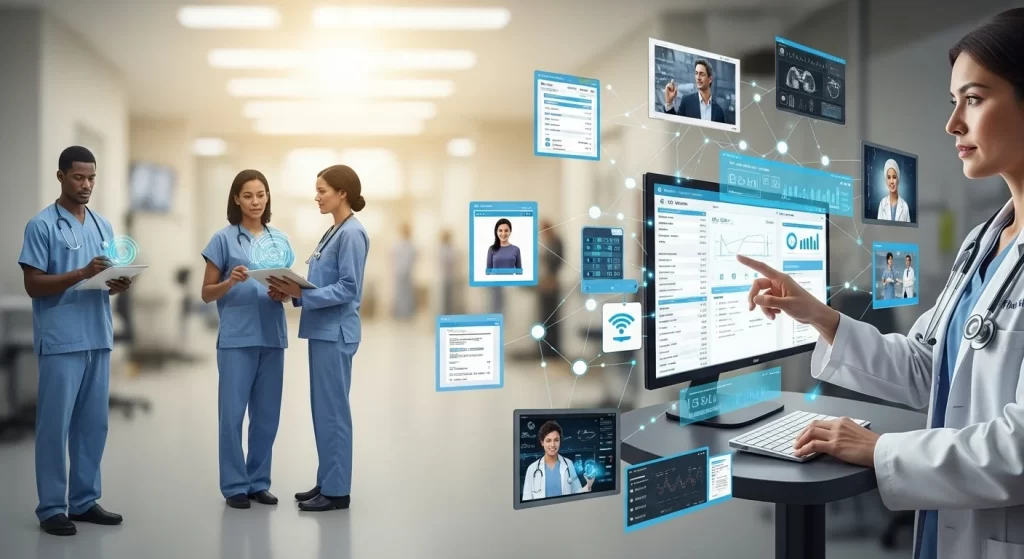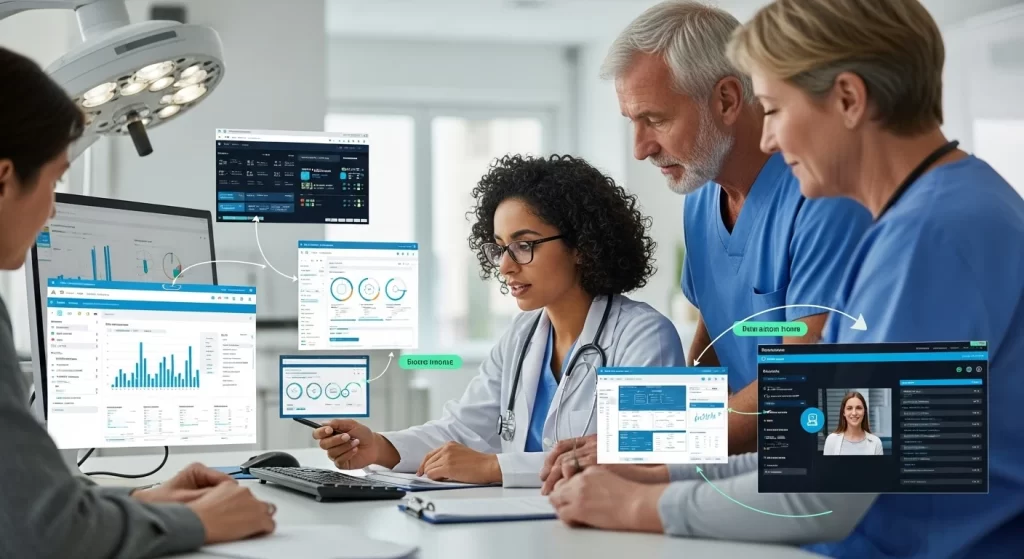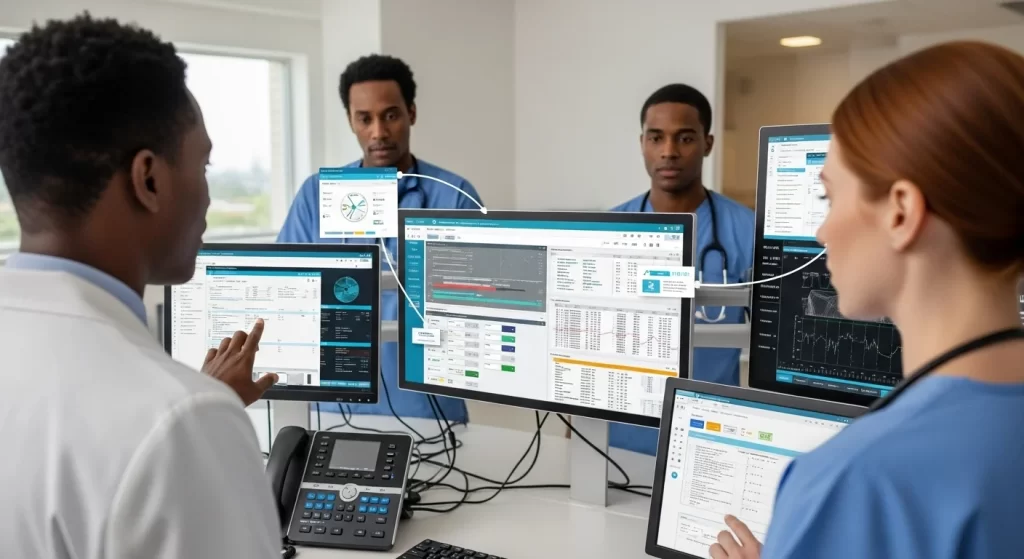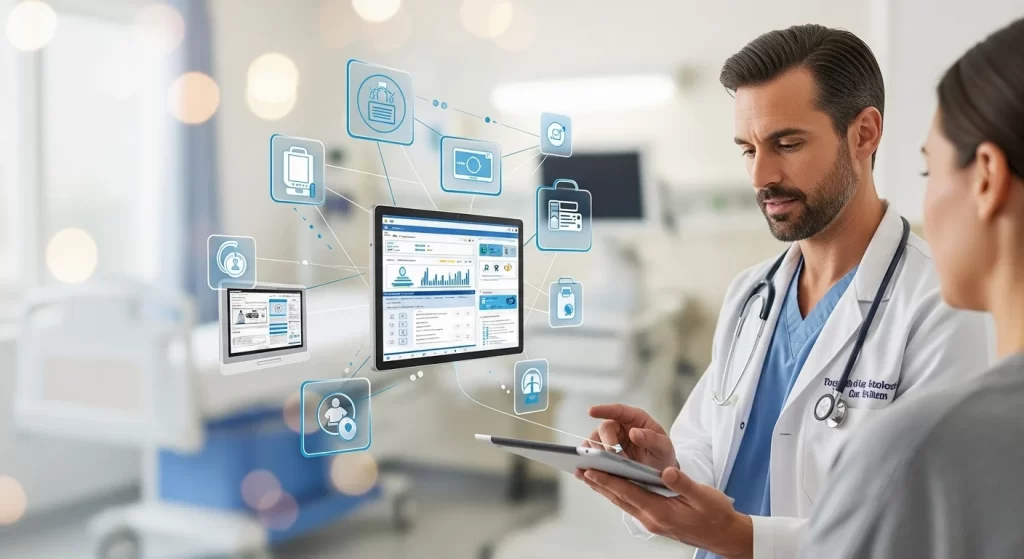The future of healthcare envisions a seamless flow of patient data, allowing for coordinated, holistic, and personalized care. This ideal contrasts with the current fragmented reality, where patient information is often trapped in isolated systems. This fragmentation costs the U.S. healthcare system hundreds of billions of dollars annually, with a significant portion attributed to inefficient data utilization.

Interoperability is not just a technical fix but a strategic necessity to unlock data flow, foster innovation, and build a truly connected care ecosystem. It is a foundational prerequisite for leveraging advanced technologies like AI, as data silos hinder AI’s accuracy and reliability. This report will examine the causes of data fragmentation, outline strategies for achieving robust interoperability, quantify its benefits, address challenges, and explore future trends, providing a comprehensive guide on how to improve interoperability in healthcare.
Ready to transform your fragmented data into a connected ecosystem? Contact us and learn how to enhance interoperability in healthcare with SPsoft!
The Fragmented Reality: Why Healthcare Data Silos Persist
Despite the clear benefits of seamless data exchange, healthcare data silos persist due to a complex interplay of historical, technical, organizational, and cultural factors.

Historical & Technical Roadblocks
Foundational technical limitations and a lack of universal agreement on data standards significantly hamper the journey toward a connected healthcare ecosystem.
Legacy Systems and Proprietary Data Formats
Many healthcare organizations still rely on outdated Electronic Health Record (EHR) systems and IT platforms not designed for modern data exchange. These “digital dinosaurs” often use proprietary data formats, making seamless integration difficult. The accumulation of technical debt from decades of underinvestment in IT infrastructure complicates this. Key issues with legacy EHRs include:
- Outdated technology often lacks modern features, such as telemedicine or advanced analytics.
- Limited interoperability due to proprietary formats.
- Significant security vulnerabilities from obsolete protocols.
- High maintenance costs require specialized IT expertise.
- Workflow inefficiencies caused by clunky interfaces.
Lack of Universal Standards and Semantic Inconsistencies
A persistent challenge is the absence of a single, universally adopted standard for all types of healthcare data. That leads to health information systems operating with proprietary formats and unique data elements, resulting in non-interoperable data versions. Even existing standards, such as HL7, FHIR (Fast Healthcare Interoperability Resources), and C-CDA, suffer from inconsistent adoption.
Semantic interoperability, which ensures the precise meaning of information is maintained and understood consistently across different systems, is a critical hurdle. Without it, automated data exchange is difficult, often requiring human intervention. Achieving genuine “connected care” requires moving beyond mere data transfer to a shared understanding of clinical meaning. That necessitates not only technical solutions but also organizational and cultural alignment around standardized vocabularies.
Organizational & Cultural Hurdles
Deeply ingrained organizational behaviors and cultural factors significantly impede the widespread adoption of interoperability.
Information Blocking and Competitive Dynamics
Even when technical solutions are available, competitive pressures can lead to “information blocking,” actively hindering data flow. That can involve restrictive contractual limitations, excessive fees for EHR interfaces, or implementing health IT in non-standard ways.
The 21st Century Cures Act aimed to prohibit information blocking; however, competitive dynamics can still foster “confined ecosystems,” where vendors design platforms to make data transfer difficult. That benefits individual vendors by locking in customers but undermines broader interoperability goals. Economic disincentives need to be removed through targeted subsidies and procurement policies to foster an open data exchange environment.
Trust, Privacy Concerns, and Workflow Disruptions
Concerns about patient data privacy and security significantly hinder the development of interoperable solutions. A 2022 AMA survey showed over 92% of patients believe privacy is a fundamental right. Nearly 75% expressed concern about protecting their health data. This multi-layered trust deficit, where patients distrust data use, and clinicians worry about security, creates a significant non-technical barrier. Overcoming this requires transparency, clear communication, and robust governance frameworks.
Clinicians’ resistance to change and perceived workflow disruptions also slow adoption. Clinicians often prefer low-risk solutions that integrate easily into existing workflows. Common reasons for clinician resistance include:
- Perceived disruption to established workflows.
- Concerns about increased workload and “button clicking.”
- Skepticism about the accuracy of new tools.
- Lack of clear understanding of the benefits.
- Prior negative experiences with clunky systems.
- Insufficient training and support.
Prior negative experiences with poorly implemented EHRs further fuel this resistance.
Strategic Pathways: How to Improve Interoperability in Healthcare
Achieving robust healthcare interoperability requires a multi-faceted approach, focusing on modernizing data exchange standards, strengthening data governance, and fostering strategic partnerships.
Adopting Modern Data Exchange Standards
The foundation of improved interoperability lies in moving away from outdated, proprietary systems towards open, standardized data exchange.
Embracing FHIR and API-First Approaches
Fast Healthcare Interoperability Resources (FHIR) is a modern, agile standard developed by HL7, leveraging contemporary web technologies like RESTful APIs. FHIR addresses the limitations of older standards by enabling modular, API-based data exchange. Its strength lies in granular “resources,” which represent discrete pieces of healthcare information (e.g., a medication order). These resources combine to form comprehensive patient records that can be easily shared between systems.
The benefits of an API-first strategy, utilizing RESTful APIs, are substantial. They are lightweight, ensure rapid data transfer, and are highly scalable and flexible, enabling seamless integration. This approach facilitates secure, real-time data exchange and eliminates the need for manual data entry. SMART on FHIR builds on FHIR by providing open standards for secure EHR data access, promoting interoperability and security for patient-facing and provider-facing applications. The table below highlights the evolution:
| Feature | HL7 v2 | FHIR |
|---|---|---|
| Standard Type | Messaging standard | API-based standard |
| Data Format | Pipe-delimited text | JSON/XML |
| Communication Protocol | TCP/IP | RESTful APIs |
| Modularity | Less modular | Highly modular (resources) |
| Ease of Implementation | Complex/custom interfaces | Easier/faster implementation |
| Focus | Clinical messaging | Web-based data exchange |
| Semantic Interoperability Approach | Less explicit/vendor-dependent | Resource-oriented/explicit concepts |
| Key Advantages | Widely adopted | Modern, flexible, mobile-friendly |
| Key Limitations | “Conditional optionality,” lack of web support, rigid | Still evolving, legacy integration challenges |
Key benefits of FHIR include:
- Standardized & Flexible Data Exchange: Employs modern web technologies for consistent, modular data sharing.
- Granular Data Access: Enables the exchange of specific data elements.
- Enhanced Interoperability: Reduces the need for custom interfaces and point-to-point integrations.
- Scalability & Efficiency: Designed for high data volumes, supporting real-time exchange.
- Innovation Catalyst: Provides a foundation for developing new applications.
- Regulatory Alignment: Increasingly mandated by government initiatives.
FHIR is positioned as the universal translator for the digital health ecosystem, lowering technical barriers for new digital health solutions and fostering a more competitive market. That shows how to improve interoperability in healthcare at a fundamental level.
Leveraging Health Information Exchanges (HIEs)
Regional and national Health Information Exchanges (HIEs) play a pivotal role in facilitating secure data sharing across disparate organizations, serving as central hubs for connected care. HIEs empower providers to access a comprehensive view of a patient’s medical history, improving care coordination and reducing redundant testing.
HIE models vary, including centralized, federated, and hybrid approaches. Initiatives like the Trusted Exchange Framework and Common Agreement (TEFCA) aim to establish a nationwide network of Qualified Health Information Networks (QHINs) to simplify data exchange.
Successful HIE models incorporate:
- Engaging stakeholders from the outset.
- Effectively utilizing interoperability standards like FHIR.
- Leveraging real-time analytics.
- Establishing financial incentives for participation.
- Prioritizing robust privacy and security measures.
For example, the University of Maryland Medical Center achieved a 30% reduction in duplicate testing by integrating data through an HIE. The table below illustrates HIE models:
| Model Type | Description | Operational Mechanism | Advantages | Disadvantages |
|---|---|---|---|---|
| Centralized | All data stored in a single repository | Participants submit data to central entity | Simplified management, easier aggregation | Single point of failure, high storage costs |
| Federated | Data remains at source, HIE acts as directory | HIE queries data from source systems as needed | Data under local control, higher security | Complex query management, data inconsistency |
| Hybrid | Combines elements of both models | Some data centralized, other data queried | Balances control with aggregation benefits | Increased complexity in design and governance |
HIEs are the connective tissue enabling coordinated care at the regional level, bridging individual providers, hospitals, labs, and public health agencies. Their evolution points towards a more integrated national health information infrastructure.
Enhancing Data Governance and Quality
Beyond technical standards, the effective management and quality of healthcare data are paramount for true interoperability.
Implementing Robust Data Governance Frameworks
A robust data governance strategy is essential for ensuring data quality, consistency, and security across interconnected systems, as well as for supporting regulatory compliance. It establishes a framework encompassing policies, procedures, standards, data ownership, roles, and accountability throughout the data lifecycle. Key components include controlling access, tracking views, preventing unauthorized access, and managing storage, sharing, and deletion. Data stewardship ensures patient data is accurate, reliable, and securely stored.
Without robust data governance, even advanced technical solutions will fail. Poor data quality and inconsistent standards undermine trust and lead to inaccurate insights. Best practices for healthcare data governance include:
- Define clear roles and responsibilities for data owners and stewards.
- Implement robust policies for data collection, retention, use, and sharing.
- Prioritize data quality through cleansing, validation, and monitoring.
- Ensure regulatory compliance with HIPAA, GDPR, etc.
- Leverage technology like data cataloging and metadata management.
- Foster a data culture through training and education.
- Secure executive buy-in to drive governance efforts.
Harmonizing Clinical and Administrative Terminologies
Standardized terminologies, such as SNOMED CT, LOINC, and RxNorm, are crucial for bridging semantic gaps and ensuring consistent data understanding. These vocabularies provide accessible meaning for clinical concepts and simplify data searching. Medical terminology forms the “backbone of healthcare communication,” promoting accuracy and efficiency.
AI-powered tools, particularly Natural Language Processing (NLP) and Machine Learning (ML), are significantly enhancing semantic interoperability. These technologies can decode complex healthcare language, extract medical entities from raw text, and map disparate terminologies to standard vocabularies. Semantic AI can reconcile different vocabularies and normalize data formats, acting as real-time data translators. That is especially important for unstructured free-text notes. AI is key to unlocking semantic meaning from this “dark data,” improving data quality for analytics and providing comprehensive patient records.
Modernizing Infrastructure and Partnerships
A robust technological infrastructure and collaborative relationships are fundamental to achieving comprehensive interoperability.
Cloud Migration and Scalable Architectures
Migrating to cloud-based infrastructure offers significant advantages for healthcare organizations, supporting greater scalability, flexibility, and interoperability. Cloud solutions can integrate multiple data sources, providing a unified platform for storing, processing, and analyzing information, managing exponential data growth.
Benefits include:
- Cost savings by reducing physical server maintenance.
- Scalability with pay-as-you-go models.
- Improved data accessibility and interoperability.
- Faster innovation through flexible infrastructure for AI and ML.
While security is a paramount concern, cloud providers often offer superior security measures compared to many on-premises systems. Essential cybersecurity measures in the cloud include:
- Robust encryption for data in transit and at rest.
- Strong access controls (RBAC, MFA).
- Regular updates and patching.
- Continuous monitoring and auditing.
- Implementation of firewalls and file integrity controls.
- Secure backups and disaster recovery.
- Execution of Business Associate Agreements (BAAs).
Cloud migration is a strategic investment in an organization’s interoperability foundation, providing infrastructure for real-time data exchange and computational power for advanced analytics.
Strategic Vendor Collaboration and Ecosystem Building
Effective collaboration with EHR vendors, IT solution providers, and other stakeholders is crucial for driving greater interoperability and cultivating a truly connected ecosystem. That involves engaging all stakeholders to align interoperability efforts with broader industry needs.
The importance of open APIs from vendors cannot be overstated. Open APIs act as “digital bridges,” enabling different software systems to communicate seamlessly. That breaks down data silos, streamlines workflows, and provides real-time access to data. Open APIs facilitate customization, enhance interoperability, and enable more comprehensive data insights. Government regulations now require healthcare providers to implement API services, granting consumers direct connectivity to their healthcare data and signaling a fundamental shift.
Open APIs democratize innovation in healthcare by lowering barriers for new solutions to integrate with existing EHRs. That fosters a more competitive market, encouraging the development of specialized solutions. Collaborative initiatives, like the COVID-19 Interoperability Alliance, demonstrate the power of bringing diverse stakeholders together to create standardized datasets.
Organizations should leverage multiple interoperability solutions, combining HIEs, vendor-driven networks, and national frameworks, to ensure comprehensive access to data. That illustrates how to improve interoperability in healthcare through collaborative efforts.
The Power of Connection: Benefits Achieved by Improved Interoperability
The transition to a seamlessly connected healthcare ecosystem yields profound benefits across patient care, operational efficiency, and innovation.

Elevated Patient Outcomes and Safety
Improved interoperability directly translates into tangible improvements in patient care and safety, fostering a more secure and effective healthcare experience.
Enhanced Care Coordination and Continuity
Improved interoperability enables the seamless sharing of patient data across different providers and care settings, leading to better-coordinated and holistic care. That ensures every member of a patient’s care team has access to timely, accurate, and comprehensive health data. The result is improved handoffs between care settings, which can lead to reduced readmissions.
For example, HIE alerts have been shown to enable proactive follow-up, resulting in a 15% decrease in hospital readmissions in some instances. Interoperability also allows providers to track patients with severe illnesses across multiple specialists, supporting the shift toward value-based care.
Reduced Medical Errors and Adverse Events
Readily available, comprehensive patient information significantly reduces the risk of medical errors, duplicate tests, and adverse drug events. When EHRs are interoperable, they contribute to a substantial reduction in medication errors; a systematic review found a 46% decrease in medication errors following EHR implementation. These systems provide crucial alerts for potential medication interactions and allergies.
Interoperability also minimizes the need for duplicate tests and procedures. Patient misidentification, a top threat to patient safety, can lead to incorrect treatments. Universal Patient Identifiers (UPIs) can significantly mitigate this risk by linking all records to a single, consistent patient identity. The infographic elements below illustrate the impact:
| Area of Impact | Quantitative Benefit / Implication |
|---|---|
| Medication Errors | 46% reduction with EHRs; 27% reduction in errors, 34% reduction in ADEs |
| Duplicate Tests | $8 billion annual savings from eliminating redundant tests |
| Patient Misidentification | Top 10 threat to patient safety; 9% of wrong-patient events resulted in harm/death |
| Overall Healthcare Waste | 20-25% of U.S. healthcare spending wasted; 50-75% preventable, saving $500-$750 billion annually |
Driving Operational Efficiency and Cost Savings
Improved interoperability not only enhances patient care but also significantly boosts operational efficiency and generates substantial cost savings.
Streamlined Workflows and Reduced Administrative Burden
Seamless data exchange automates manual tasks, reduces redundant data entry, and dramatically improves workflow efficiency for clinicians and administrative staff. That frees up valuable human resources to focus on direct patient care. Interoperability ensures faster access to patient data, significantly reduces administrative burdens, and optimizes resource allocation. It can simplify complex administrative tasks, such as insurance claims processing, appointment scheduling, and patient billing.
Optimized Resource Utilization
A unified view of patient data enables more effective resource allocation, reduces unnecessary tests, and optimizes bed utilization. That contributes to significant cost savings by minimizing redundant procedures. Utilization management, supported by comprehensive EHRs and advanced data analytics, helps identify trends and pinpoint opportunities for improvement. For example, a health plan using data analytics for care management achieved a 25% reduction in hospital readmissions and a 20% reduction in unnecessary testing.
Interoperability serves as a strategic lever for significant, long-term cost reduction across the entire healthcare system. Key areas of cost savings include:
- Reduced Duplicate Tests & Procedures: Eliminating unnecessary lab work and imaging.
- Streamlined Administrative Tasks: Automating claims processing and billing.
- Optimized Resource Allocation: Better management of beds, equipment, and staff.
- Prevention of Medical Errors: Avoiding costly complications from errors.
- Lower Readmission Rates: Proactive care coordination reducing preventable hospital readmissions.
- Improved Patient Flow: Faster diagnoses and treatment, reducing length of stay.
Interoperability enables healthcare to transition from a reactive to a proactive, continuous care model. By having a unified view of patient data, providers can identify at-risk patients, intervene earlier, and tailor care plans more effectively, leading to improved outcomes and significant cost savings. This shift is critical for the success of value-based care models.
Fueling Innovation and Patient Empowerment
Beyond efficiency, interoperability is a powerful catalyst for innovation and a fundamental enabler of patient empowerment.
Powering Advanced Analytics and AI Applications
Robust interoperability provides the foundational, high-quality data necessary to fuel advanced analytics, machine learning, and AI applications. Data is the “fuel” for AI; the quality of this data is paramount, as “garbage in, garbage out” applies directly to AI model performance. AI can analyze vast amounts of interoperable data for:
- Predictive analytics: Identifying patients at high risk of readmission or adverse outcomes.
- Clinical decision support: Recommending next steps and matching treatment plans.
- Automating tasks: Streamlining workflows in medication management or order placement.
Semantic AI is transformative, moving beyond simple data exchange to truly understand the meaning of data. It can reconcile different vocabularies and normalize formats. The concept of AI models being trained on “collective patient EHR data” and through “federated learning across institutions” suggests a move towards a “learning healthcare system” where data continuously refine AI models. That creates a virtuous cycle where interoperability improves data, which in turn improves AI and ultimately enhances care.
Greater Patient Access and Engagement
Patient-facing APIs and improved data access empower individuals to take a more active role in their health management, access their records, and share information securely. Patients are increasingly expecting to own and access their healthcare information. Research consistently demonstrates that providing patients with access to their data leads to improved medical outcomes, lower treatment costs, increased engagement, and reduced anxiety. For example, a study found that 60% of patients with access to their doctor’s notes were more likely to take their medical care seriously.
Patient portals provide secure access to personal health information, resources, and services. These portals have the potential to significantly enhance patient engagement, reduce costs, and improve overall healthcare quality. Patient empowerment, facilitated by interoperability, is a strategic lever for improving health outcomes and reducing costs. Healthcare systems should actively design interoperable solutions that prioritize patient access and engagement.
Adoption Realities: Navigating the Journey to Interoperability
While the benefits of interoperability are clear, the path to achieving it is fraught with practical challenges that require careful navigation.

Overcoming Technical and Financial Hurdles
The modernization of healthcare IT systems involves significant technical complexities and substantial financial investments.
Integrating Legacy Systems and Data Migration
Extracting, transforming, and loading (ETL) data from outdated legacy systems into new interoperable platforms is complex. Healthcare data is vast, complex, and originates from numerous sources. Key challenges include ensuring data integrity, managing system downtime, and maintaining the overall quality of data. Proprietary formats necessitate numerous data conversion cycles. Data quality issues, such as inaccurate entries, inconsistent formats, and duplicates, are common.
Strategies for minimizing disruption during data migration include:
- Utilizing middleware and integration platforms that act as translators.
- Adopting phased and incremental modernization approaches.
- Adhering to interoperability standards for data accuracy.
- Implementing robust ETL processes to ensure clean, validated data.
Budgetary Constraints and ROI Justification
Limited budgets and perceived high upfront costs often hinder the adoption of interoperability, especially for smaller providers. Implementing interoperable systems requires substantial initial investments in IT infrastructure, software, and training. Organizations may struggle to see immediate value.
However, interoperability can reduce redundant testing, shorten inpatient stays, and bolster ROI. Practical strategies for demonstrating long-term ROI involve quantifying savings from reduced duplicate tests, improved coding accuracy, and labor hour savings. It is crucial to view IT integration as a strategic investment impacting financial performance. The ROI justification is a continuous value proposition tied to strategic business imperatives. Healthcare organizations need to develop sophisticated ROI models that capture both direct and indirect benefits.
Ensuring Security, Compliance, and User Adoption
Beyond technical and financial considerations, addressing security, regulatory compliance, and the human element of adoption are paramount.
Robust Cybersecurity and Regulatory Compliance
Comprehensive cybersecurity measures are crucial for protecting patient data during exchange. Data breaches in healthcare have reached an all-time high. Organizations must diligently maintain compliance with regulations, such as HIPAA, GDPR, and the 21st Century Cures Act. The complexity of overlapping regulations can hinder the exchange of legitimate data.
Essential cybersecurity measures for healthcare interoperability include:
- End-to-end encryption for data in transit and at rest.
- Strong Access Controls (RBAC, MFA).
- Regular Risk Assessments & Audits.
- Business Associate Agreements (BAAs) with third-party vendors.
- Data De-identification/Anonymization for research purposes.
- Secure Backups & Disaster Recovery.
- Continuous System Updates & Patching.
Effective cybersecurity requires a shift from viewing it solely as an IT department’s responsibility to a shared organizational culture of security awareness and responsibility. Human error remains a significant vulnerability. That highlights how to improve interoperability in healthcare by focusing on security.
Clinician Engagement and Workflow Adaptation
Engaging clinicians and staff early in the interoperability journey is paramount for successful user adoption. Many clinicians are skeptical of change, especially if they perceive new systems will disrupt workflows. Prior negative experiences with poorly implemented EHRs further fuel this resistance.
Practical strategies for user adoption and change management include:
- Communicate the “Why”: Articulate benefits to gain buy-in.
- Involve Clinicians Early: Include end-users in planning and feedback.
- Prioritize Workflow Integration: Design solutions that minimize disruption.
- Provide Comprehensive Training & Support: Offer structured, ongoing training.
- Pilot & Phase Rollouts: Implement incrementally to identify issues early.
- Foster a Culture of Adaptability: Encourage open communication and celebrate successes.
- Select User-Centric Vendors: Partner with vendors prioritizing usability.
The technical capability to exchange data is meaningless if clinicians do not use the systems effectively. The true success of interoperability initiatives hinges on user adoption, necessitating a human-centered approach focusing on change management, clear communication, workflow optimization, and continuous support.
The Future of Interoperability and Connected Care
The trajectory of healthcare interoperability points towards a unified horizon, driven by technological advancements and an expanding scope of interconnectedness.

Advancements in Data Exchange Technologies
The future of healthcare data exchange will be defined by the integration of cutting-edge technologies and a renewed focus on consistent patient identification.
AI and Blockchain for Enhanced Interoperability
Emerging technologies, such as Artificial Intelligence (AI) and blockchain, are poised to enhance healthcare interoperability significantly. AI will play a crucial role in semantic interoperability, enabling the understanding of unstructured data, improving data quality, and powering predictive analytics. Federated learning will improve collective value by training AI models across multiple institutions without directly moving raw patient data. Generative AI models are already demonstrating capabilities in drafting clinical notes and acting as real-time data translators.
Blockchain technology, with its decentralized, immutable, and transparent nature, provides a viable solution for secure and auditable data sharing. It ensures tamper-proof storage of electronic health records and can automate patient consent verification. The convergence of AI and blockchain promises enhanced security, privacy, and interoperability, creating a system where data integrity and appropriate use are built-in. This intelligent trust could revolutionize clinical trials, drug discovery, and personalized medicine.
Universal Patient Identifiers and Data Normalization
The potential impact of universal patient identifiers (UPIs) or more advanced data normalization techniques on achieving true, widespread interoperability is profound. A UPI standardizes patient identification by assigning a unique code that links records across different healthcare facilities to create a singular, comprehensive patient view.
Without UPIs, duplicate patient records and misidentification are common, leading to missed information, incorrect treatments, and unnecessary costs. Data normalization involves organizing patient data into consistent formats, adjusting medical records to ensure consistency across sources, and removing duplicates.
This process improves data quality, enhances patient safety, and provides trusted insights for data analytics. A national UPI, despite historical privacy concerns, is a foundational element for achieving true, widespread interoperability, which dramatically improves patient safety, reduces healthcare waste, and enables more accurate population health management.
Expanding Scope and Global Connectedness
The future of interoperability will extend its reach, encompassing a broader spectrum of health data and transcending national borders.
Interoperability Across the Care Continuum
Interoperability will increasingly extend beyond traditional acute care settings to encompass mental health, social determinants of health (SDOH), and long-term care, fostering truly holistic patient records. Collecting and exchanging SDOH data (e.g., food insecurity and housing instability) is critical for addressing health equity.
The Gravity Project is actively developing FHIR-based implementation guides for SDOH data exchange, indicating that interoperability extends beyond medical treatment to encompass understanding broader social and environmental factors that impact health. The future of connected care will integrate healthcare data with social and community data, necessitating solutions that can handle diverse data types from non-traditional sources. This holistic view is crucial for achieving accurate health equity and moving towards preventative, community-based care models.
Global Data Exchange and Public Health Initiatives
Aspirations for international health data exchange are growing, driven by the need to support global public health initiatives, cross-border research, and seamless care for individuals moving between countries. The World Health Organization (WHO) defines interoperability broadly, emphasizing its importance “within and across organizational, regional, and national boundaries.”
However, significant challenges persist, including heterogeneous data formats, varied regulations across countries, and concerns about the use and privacy of data. Despite these hurdles, the benefits of easier sharing of health data across borders for public health surveillance are widely recognized. Global interoperability is not just a technical challenge but a complex one that involves geopolitics and law. Achieving global health data exchange requires international collaboration on harmonized legal frameworks, data governance, and ethical guidelines, in addition to technical standards.
Conclusion
A concerted effort to understand how to improve interoperability in healthcare is the unifying force that will overcome entrenched data silos and fundamentally transform the industry. That is not merely a technological upgrade but a profound shift in how healthcare operates, moving from fragmented, episodic care to a truly integrated and proactive system.
The profound impact of this transformation is evident across multiple dimensions. It significantly improves patient safety and outcomes by reducing medical errors, enhancing care coordination, and ensuring continuity of care. It drives substantial operational efficiency and cost savings by streamlining workflows, reducing administrative burdens, and optimizing resource utilization, resulting in billions of dollars in annual savings.

Moreover, interoperability unlocks unprecedented opportunities for innovation, fueling advanced analytics and AI applications that enable predictive insights and personalized medicine. It also empowers patients, granting them greater access to and control over their health information, which demonstrably leads to better health outcomes and increased engagement.
Navigating the complexities of legacy system integration, ensuring robust data governance and quality, and fostering clinician adoption are critical challenges that require strategic vision and specialized expertise. The future promises further advancements, with AI and blockchain enhancing data exchange security and semantic understanding, as well as the expansion of interoperability to encompass social determinants of health and global data exchange.
SPsoft possesses deep expertise in designing, developing, and securely implementing bespoke interoperability solutions. These solutions are compliant with stringent regulations, highly effective, and meticulously tailored to the unique demands of a connected healthcare ecosystem, helping organizations navigate the complexities of legacy systems, data governance, and regulatory compliance.
Partner with us to build a seamlessly connected medical future. Learn how to improve healthcare interoperability with our expert development and integration services!
FAQ
Why can’t my new doctor easily see the records from my old one?
This is due to a lack of interoperability. Your health information is often trapped in isolated “data silos.” Many hospitals and clinics use outdated legacy systems or proprietary formats that weren’t designed to share data with others. This fragmentation is a significant problem, costing the U.S. healthcare system hundreds of billions of dollars annually and hindering coordinated care.
What is “information blocking” in healthcare?
Information blocking is the active and often intentional hindrance of data flow between systems. Even when technology enables data sharing, some EHR vendors or healthcare systems may create contractual or technical barriers to keep patients and their data locked within their specific ecosystem. This anticompetitive practice undermines the goal of creating a truly connected care network for patients.
What is FHIR, and why is it a game-changer for my health data?
Think of FHIR (Fast Healthcare Interoperability Resources) as a universal translator for health data. It’s a modern standard that utilizes web-based APIs—similar to those used by social media or banking apps—to enable different healthcare systems to communicate seamlessly. It enables the secure, real-time exchange of specific pieces of health information (like a single lab result), making it easier to build innovative apps and connect your care.
Can connecting my health records make my care more effective and safer?
Absolutely. When your care team has a complete and up-to-date view of your health history, the risk of dangerous mistakes drops significantly. Interoperable electronic health records (EHRs) have been shown to reduce medication errors by 46%. They also help eliminate unnecessary duplicate tests and prevent patient misidentification, which is a top threat to patient safety.
Why are some clinicians resistant to new, connected systems?
Clinician resistance often stems from past negative experiences with clunky EHRs that disrupted their workflows and increased their administrative burden. Many are skeptical that new tools will be any different, fearing more “button clicking” and a loss of focus on the patient. Overcoming this requires solutions that are designed to be intuitive, integrate seamlessly into existing routines, and have clear, communicated benefits.
How does better data sharing help to power AI in medicine?
High-quality, interoperable data is the “fuel” for Artificial Intelligence. AI models need vast amounts of connected data to learn, make accurate predictions, and provide reliable clinical decision support. Without interoperability, AI is “starved” of the comprehensive data it needs to function effectively. A seamless data flow is the foundational prerequisite for leveraging advanced AI to improve diagnoses and personalize treatments.
What are Health Information Exchanges (HIEs)?
Health Information Exchanges (HIEs) are like central hubs or digital town squares for health data. They securely connect different healthcare organizations within a region—such as hospitals, labs, and clinics—allowing them to share patient information. That helps create a comprehensive community health record, which has been shown to reduce hospital readmissions by 15% and decrease duplicate testing by 30%.
How does moving to the “cloud” help hospitals share data?
Migrating to cloud-based infrastructure offers hospitals greater scalability, flexibility, and security. Instead of relying on expensive, on-site physical servers, the cloud offers a unified and modern platform for storing and processing information from various sources. That makes it much easier to integrate data, support real-time data exchange, and provide the computational power needed for advanced AI and analytics applications.
What are “social determinants of health,” and why should my doctor care about them?
Social determinants of health (SDOH) are non-clinical factors, such as housing situation, access to transportation, and food security, that have a significant impact on your well-being. The future of interoperability is expanding to include this data, providing your care team with a more comprehensive picture of your life. That allows them to address underlying issues that affect your health and work towards more equitable care.
What is a Universal Patient Identifier (UPI), and do I have one?
A Universal Patient Identifier (UPI) is a unique code that links all your health records from different facilities into a single, comprehensive patient view. Currently, the U.S. lacks a national UPI standard, which is why patient misidentification and duplicate records are common issues. Experts agree that a UPI is a foundational element for achieving true, widespread interoperability and dramatically improving patient safety.



